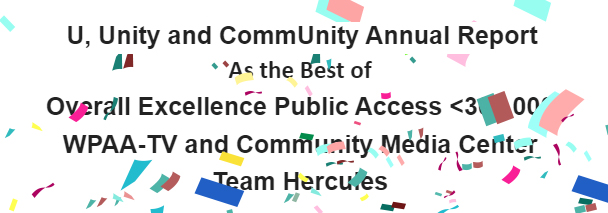Published Record-Journal Weekender Op-Ed June 3, 2023
In June, WPAA-TV turns 30, but the legacy of community media in Wallingford is 48 years deep. All community media in Wallingford originated in 1975 with a state grant to the library for a community bulletin board. The “What is happening at the library?” show, 200 North Main St, had been the longest-running community media program in Connecticut. Discontinued during the pandemic, WGTV has no plans for its return. The library is now podcasting.
Also in June, WPAA-TV is receiving, for the fourth time in five years, the Alliance for Community Media Hometown Festival Award for ‘Overall Excellence’ as a small public access station. This honor suggests that WPAA-V is reaching, or exceeding, all expectations tied to its mission to provide a space for the people of Wallingford to express their ideas, and talents and share stories.
Less celebratory is how Wallingford is an outlier in a legislative study of community media a.k.a. Public, Education, and Government (P.E.G.) in Connecticut (PURA DOCKET NO. 22-06-26). This study is reviewing the potential of ‘statewide’ community media provider consolidation, funding options and limits.’
With a study seeking to ‘consolidate’ access providers, reduce costs and ensure accountability; Wallingford stands out for a few reasons. Among them is the existence of two recording locations for government TV and a third independent public access studio. Ironically, this has led to an exceptional amount of state technology grants to Wallingford. Other eccentricities appear in annual reports. When filed, the education channel report incorrectly identifies the channel it administers. The WPAA-TV Public Access report includes government & education activity.
Idiosyncrasies garner more scrutiny. When a 1999 PURA Docket initially designated WPAA-TV as the sole recipient of subscriber fees ‘remaining’ in Wallingford, it was inclusive of a requisite obligation to cablecast content the other local channel administrators chose not to provide. This commingling, coupled with an annual average of $20,000 of Wallingford subscriber fees authorized to be distributed by cable companies to the franchise towns of Madison, Guilford, No. Branford and No. Haven, begs the question, “Why?”.
In 2008, WPAA-TV volunteers sought to purchase the Parade Ground property adjacent to the Town Hall, now owned by a family. Testimony established that Wallingford had the most expensive Government Access channel in CT. They suggested consolidation. Their purchase and consolidation proposal conservatively would have saved Wallingford taxpayers a million dollars. It also could have optimized the technology grants that did not yet exist. The primary source of resistance to local consolidation has been the mayor. Since the mayor of 40 years is not running in 2023, local elections may open the door to a review of consolidation — assuming Wallingford is not targeted to be merged with other franchise towns.
There are two other complex and significant factors playing into the study’s outcome: the disputed origin and purpose of community media funding and the vast technological change since the inception of Cable TV. Undeniably, more people have access to tools to create media and there are several platforms for distribution. Even the legacy library show has been supplanted with podcasting.
Among fifty questions posed to nonprofit cable access providers, study administrators requested revenue and expense details for the last four years from all providers in the state. The last filing date is June 7th. Study recommendations are to be submitted to the Technology Committee of the General Assembly by December 15th. While it is too soon to predict the outcome, the words ‘consolidation’, ‘eliminate’, and ‘merge’ loom assertively above discussion of what constitutes meaningful community media today.
Connecticut (CT) is among a handful of states committed to enabling community media in every community. Yet, CT has the most complex mechanism for providing & funding P.E.G. in the nation. It is a hodgepodge of corporate, regional, town, and mixed-service models with significant variation in channel capacity allocations. Its evolution is firmly rooted in a Yankee paradigm; a worldview that presumes to foster local democracy, open government, and civic virtue while being practical and self-reliant. Uncomfortably nestled in this hodgepodge is Wallingford. And what is at risk is the loss of WPAA-TV and Community Media Center.
The volunteers of WPAA-TV believe themselves to be stewards of what remains limitless: That community media lets you discover every day what you did not know you needed. In November, local elections may finally let us out of the dog house only to find the study sends us to the shoreline. But we want to be all in for Wallingford in Wallingford. Are you with us?

